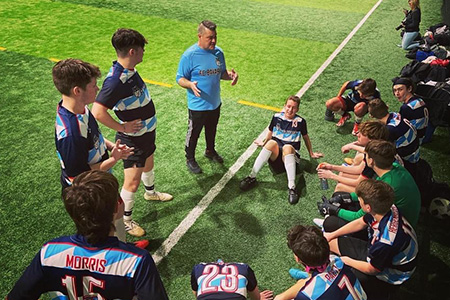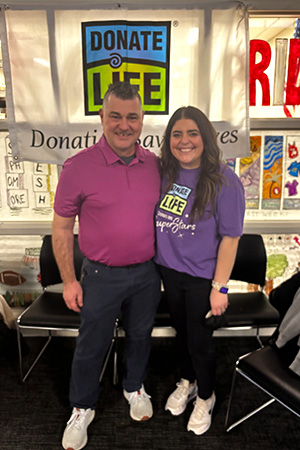Paul’s Journey to Finding His Voice Again
Paul Morris, an engineer in Frankenmuth, Michigan, lived a busy life as a husband, father, and active community member—until everything came to a halt in March 2021.
 He contracted COVID-19 and managed his symptoms at home for a week and a half. “I seemed to be doing pretty well at home, but then I started having a lot of trouble breathing and finally decided I should go to the emergency room to get checked out,” remembered Paul.
He contracted COVID-19 and managed his symptoms at home for a week and a half. “I seemed to be doing pretty well at home, but then I started having a lot of trouble breathing and finally decided I should go to the emergency room to get checked out,” remembered Paul.
At the emergency room of a local health system, his vitals were taken, and his low oxygen levels prompted immediate admission to the COVID intensive care unit.
His condition rapidly declined, and he was induced into a coma and placed on a ventilator. After three weeks, doctors told Paul’s wife, Laura, that his lungs were so brittle and scarred that he might never recover unless he received a lung transplant.
Without hesitation, Laura began contacting major health systems in Michigan that perform lung transplants. Eventually, they found their way to Henry Ford. Two weeks later, on May 7, Paul received a double lung transplant.
The real work begins
 When Paul woke up, the real work began. “There was a lot to process. I was awakened two days after my lung transplant and didn’t know where I was. My body had been through an awful lot, and there was still a lot of work to do post-transplant to get back to functioning somewhat normally again,” said Paul.
When Paul woke up, the real work began. “There was a lot to process. I was awakened two days after my lung transplant and didn’t know where I was. My body had been through an awful lot, and there was still a lot of work to do post-transplant to get back to functioning somewhat normally again,” said Paul.
In the months that followed, Paul focused on healing. A multidisciplinary team of specialists supported him through pulmonary rehabilitation, gastroenterology, physical therapy, and more. As Paul continued to recover, he noticed his voice was nearly nonexistent—likely due to prolonged intubation. He began working on ways to restore it with Ross Mayerhoff, M.D., Otolaryngologist and Division Chief of Laryngology (which is a branch of medicine that focuses on the study and treatment of disorders related to the larynx, commonly known as the voice box.)
During his first appointment with Dr. Mayerhoff, Paul underwent a laryngeal videostroboscopy to assess how his vocal cords were functioning. “During the videostroboscopy, they had me do a lot of sniffing and yelling ‘E!’ to see what was happening in my vocal cords. As it turns out, my vocal cords weren’t coming together at all,” said Paul.
“I examined Paul’s glottis, which is where your vocal cords come together to produce sound. His cords weren’t coming together like they should have, and a big part of this was due to cartilage erosion from having a breathing tube there for so long. As a result, Paul’s voice was very breathy,” explained Dr. Mayerhoff.
Dr. Mayerhoff recommended vocal cord injections and vocal exercises to help strengthen the cords. During vocal cord injections, a filler agent is injected into the vocal cords to add volume and inflammation. In doing so, the vocal cords are able to close more effectively, thus improving voice quality. While this is helpful for most people whose vocal cords don’t touch, it only addressed part of the problem for Paul because it did not solve the problem of the gap in the back from the breathing tube.
Initially, Paul was satisfied with his voice, given the level of activity he was participating in at the time. But, two years later, Paul still felt that his voice was troublesome. He underwent one more vocal cord injection and worked with speech-language pathologist Anjli Lodhavia, M.S., CCC-SLP, on swallowing and voice exercises. These helped him regain some pitch range.
Still, Paul felt his voice wasn’t what it once was. He shared his concerns with Dr. Mayerhoff. Dr. Mayerhoff identified his problem as post-intubation posterior glottic insufficiency, a condition in which the back of the larynx loses some tissue because of the pressure from the breathing tube in place for days to weeks while in the ICU. This is a condition that, unfortunately, doesn’t have any well-established treatments, in contrast to the glottic insufficiency in the front part of the larynx that was addressed with the injections.
A new challenge
 Dr. Mayerhoff had been in contact with a colleague at Texas Children’s Hospital who had recently published a series of pediatric patients with the same condition that underwent a new procedure—a technique called an endoscopic posterior rotation flap. This involves creating a flap of tissue from a less critical area of the larynx, then tucking it into the area where tissue was missing. This allows the vocal cords to meet more strongly and produce a stronger, clearer sound.
Dr. Mayerhoff had been in contact with a colleague at Texas Children’s Hospital who had recently published a series of pediatric patients with the same condition that underwent a new procedure—a technique called an endoscopic posterior rotation flap. This involves creating a flap of tissue from a less critical area of the larynx, then tucking it into the area where tissue was missing. This allows the vocal cords to meet more strongly and produce a stronger, clearer sound.
“My colleague told me this procedure is most commonly done on children who were born prematurely, and the oldest patient they’d performed it on was 17 years old. While a teenager’s vocal cords are more developed, it’s still hard to compare that to a man in his 50s with damaged tissue,” said Dr. Mayerhoff. “So, I presented Paul’s case at a conference to get feedback from colleagues. The general consensus was that he shouldn’t risk what was otherwise a great outcome from a lung transplant by undergoing additional surgery. However, this newly described technique appeared less likely to pose a risk to his airway than other strategies that had been tried in the past.”
Despite the concerns, Dr. Mayerhoff continued researching and consulting with colleagues because the voice limitation was having such an impact on Paul’s quality of life. He kept Paul informed about the potential risks.
Exhausting all options
 “I noticed my speech was still breathy, and I couldn’t speak for long. I’d be gasping for air mid-sentence. I work in automation training, teaching 6–8 people at a time, so having a voice is a big part of my job. I also coach soccer, and my voice is crucial there too. Not having a voice was tough, and I wanted to exhaust all options to get it back. People would say, ‘You’re lucky to be alive and even have a voice. Why risk more?’ But I didn’t want to give up,” said Paul.
“I noticed my speech was still breathy, and I couldn’t speak for long. I’d be gasping for air mid-sentence. I work in automation training, teaching 6–8 people at a time, so having a voice is a big part of my job. I also coach soccer, and my voice is crucial there too. Not having a voice was tough, and I wanted to exhaust all options to get it back. People would say, ‘You’re lucky to be alive and even have a voice. Why risk more?’ But I didn’t want to give up,” said Paul.
In late August 2024, Dr. Mayerhoff performed the endoscopic posterior rotation flap procedure on Paul. He successfully created a flap on one of Paul’s vocal cords, significantly improving his voice.
“My voice still isn’t what it was before, but this is the closest we’ll get,” said Paul. “I’m so thankful to Dr. Mayerhoff for never giving up, listening to my concerns, and being willing to challenge himself with a procedure that hadn’t been done before on someone my age. I feel much more confident using my voice and am glad I took the risk,” reflected Paul.
“Adapting this procedure to an adult had its own challenges, but it was successful. It’s also a testament to how well his ICU and transplant care went. His lingering effects post-COVID and post-transplant were minimal, which helped make this procedure a success. We’re seeing incredible advancements in care compared to years ago. Fifteen to twenty years ago, Paul might not have survived,” said Dr. Mayerhoff, “It’s also important to have a relationship with the patient that’s built on trust, where pushing the envelope is possible. That’s what makes being a subspecialty surgeon so rewarding – he trusted me to guide him and wanted to see it through,” remarked Dr. Mayerhoff.
After his unexpected journey, Paul is now back to an active life as a husband, father of three and engineer—grateful every day for the power of speaking up.
.svg?iar=0&hash=F6049510E33E4E6D8196C26CCC0A64A4)

/hfh-logo-main--white.svg?iar=0&hash=ED491CBFADFB7670FAE94559C98D7798)